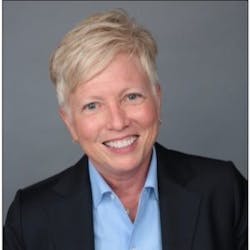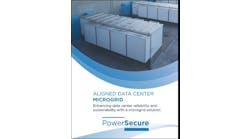“All winds are blowing in the direction of microgrids,” said Annette Clayton, CEO of Schneider North America in an interview with Microgrid Knowledge this week.
Annette Clayton, CEO of Schneider North America
The interview followed Schneider Electric’s Innovation Summit North America 2021, a Nov. 10 teleconference that focused on energy resilience and sustainability. Speakers identified trends spurring microgrids, among them adoption of electric vehicles (EV), the move to building electrification, corporate sustainability goals and demands for resilience.
Speakers at the teleconference also pointed to the newly passed bipartisan infrastructure bill, awaiting President Biden’s signature, as likely to drive microgrid adoption. The bill provides $50 billion for programs and technologies that improve resilience, $65 billion for grid improvements and $7.5 billion to build a national network of EV chargers. Also expected to create opportunities is the $17 billion slated for ports and $25 billion for airports that the bill calls for in part to reduce emissions and accelerate electrification and low-carbon technologies.
Not only are companies moving toward electrification for resilience purposes, but they’re also seeking out energy that’s located close to where it’s used, said Kevin Self, senior vice president of strategy, business development and government relations at Schneider Electric, who participated in the interview with Clayton.
To illustrate the need for microgrids as companies try to be more sustainable — electrifying buildings and vehicle fleets — Self said that some large companies like Amazon may not have enough power available from the grid. Microgrids will be an important solution.
“The whole call to action for sustainability creates opportunities for microgrids,” added Clayton.
However, microgrids aren’t always uppermost on the minds of facilities managers that Schneider talks with. Often they are interested solely in renewable energy. Schneider is working to educate such clients about the role microgrids can play in meeting their resilience and sustainability goals.
“We see education as our calling and purpose,” said Clayton.
What microgrids bring to renewables
During the teleconference, Jake Friedman, director of customer solutions and tendering at GreenStruxure, a partnership of Schneider and Huck Capital, addressed the limitations of renewable energy when it is used without other forms of energy. Microgrids typically employ multiple energy resources and bring the ability to island from the grid during a power outage, which allows them to provide electricity to their hosts.
“Solar is great for decarbonization and can be cost-effective but can’t provide resiliency,” Friedman said during a session, ‘Grids of the Future: How to Overcome Your Energy Challenges with Microgrids.’ “Solar and combined heat and power can optimize a mix of assets to deliver on customers’ requirements. How they are made to work together is the key.”
Microgrid standardization growing
In the past, microgrids were made up of customized systems. But more and more, microgrids are becoming standardized, Friedman said.
Schneider’s Energy Control Center can serve as the brains and brawn of a microgrid, said Lance Haines, chief technology officer for Schneider’s microgrid business in North America, during the microgrid session.
For example, Schneider Electric offers a web-based design suite that provides for peak shaving, islanding and other services, eliminating the need for custom engineering. But it also allows customization when needed. Ninety percent of a microgrid system may be a standard package, and 10% customized by engineers for smaller applications in the 1 MW to 5 MW size range.
Haines cited Schneider Electric’s Innovation Hub and Lab, located at the company’s headquarters in Andover, Massachusetts, outside of Boston, where the company integrated existing assets into a microgrid and expanded the loads that could be served during outages.
The building features the company’s Energy Control Center, which connects its distributed energy resources to the microgrid, providing advanced control. The microgrid also incorporates Schneider’s EcoStruxure Microgrid Advisor, which utilizes connected hardware, software and cloud-based analytics to help the campus procure energy and manage its consumption more efficiently.
Before the microgrid was added, the facility had a natural gas generator to serve its data center and critical loads during outages. The microgrid the company added included 350 kW of solar as well as storage. This allowed additional critical loads to be moved into the Energy Control Center, providing power to more loads during outages, Haines said. The solar now works with the natural gas generator during outages.
“We can provide systems with a mix of assets without having expensive control and power,” Haines said.
Watch Elisa Wood, editor-in-chief of Microgrid Knowledge, interview Annette Clayton, CEO of Schneider Electric, at Microgrid 2020 in a special panel, “Why We Were First,” about the early leaders in microgrids.
Microgrids and EVs
During another session on e-Mobility, Mike Doucleff, head of e-Mobility at Schneider Electric, said that in 2030, 30% of all vehicles will be electric. And 95% of charging will take place at home or at destinations such as workplaces.
“Drivers will charge when they stop versus stopping to charge. Homes and buildings will need more electricity and energy management,” he said. When buildings add EVs, they experience up to 40% more electricity consumption. And those who buy EVs want to fuel them with decarbonized electricity, according to Doucleff.
.
“This is where microgrids can help. They can be more sustainable and resilient,” Doucleff said.
Engineers’ dream come true
Meanwhile, home electricity consumption is expected to double by 2050, and again, microgrids can help fulfill the need for clean electricity.
Parts of the US are already committing to 100% electricity, and this can spread to many other areas of the country, according to Haines.
“The intermittent nature of renewables can be challenging. To achieve clean and reliable electricity, we have to move into the territory of the smart grid where utilities and microgrids communicate digitally,” he said.
That’s beginning to happen, and it’s a dream come true, said Haines.
“Engineers have dreamed of smart grids for years and now they are finally coming to fruition,” Haines said.
Interested in microgrids? Subscribe to the free Microgrid Knowledge Newsletter.








